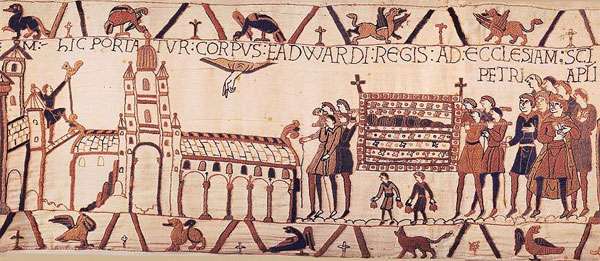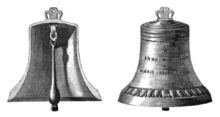Dead bell

A dead bell or deid bell (Scots), also a 'death', 'mort', 'lych', 'passing bell' or 'skellet bell'[1] was a form of hand bell used in Scotland and northern England[2] in conjunction with deaths and funerals up until the 19th century.
Origins
Belief in the supernatural was common in the Middle Ages and special protective powers were sometimes attributed to certain objects, including bells. The Church itself condoned the use of bells to frighten away evil spirits and this ensured the practice's survival and development. Bells were often baptised, and once baptised were believed by many to possess the power to ward off evil spells and spirits.[3] The use of the dead bell was typical of this belief, rung for the recently deceased to keep evil spirits away from the body.[4]
The dead bell was therefore originally rung for two reasons: firstly to seek the prayers of Christians for a dead person's soul, and secondly to drive away the evil spirits who stood at the foot of the dead person's bed and around the house.[5]
The use of the dead bell is illustrated on the Bayeux tapestry at the funeral of Edward the Confessor and may have been brought over to Britain by the Normans.[6]

Uses
Before the Reformation, friars in Glasgow rang the dead bell through the streets for the repose of the soul of the deceased, especially if the individual was a benefactor of the church. It is known that the ancient bell of Saint Mungo (aka Saint Kentigern) was used for this purpose. From 1454 a record survives of the bell being rung annually[7] for the soul of Johne Steuart (John Stewart), the first Provost of Glasgow, who had left lands and property to the church.[8] A record of 1509 for Sir Archibald Crawfurd of Cadder also shows that the ringing of the dead bell sometimes took place more than once and was intended to encourage others to pray for the deceased, his ancestors, and other Christian souls.[9] In 1594 the presbytery of Glasgow attempted to recover the right of use of the dead bell, arguing that it was an ecclesiastical and not a secular function.[10]
The ballad of Willie's Lyke-Wake from the north of Scotland records the payment of a groat for the ringing of the dead bell at his funeral by the bell-man.[11]
In later, secular times, the bell ringer would pass through the streets of villages, towns or cities announcing the name of a recently deceased person, with details of the funeral. At the funeral the bell ringer, often the beadle, would walk at the head the cortege, solemnly ringing the bell from the home of the deceased until the church was reached.[1][12] The bell was also sometimes used to indicate the point at which the coffin-bearers were changed.[13]
Kirk session records show that in one Ayrshire parish the dead bell ringer was paid at a rate of a penny a mile at first, rising to two pence per mile by 1762.[13] The income from the ringing of the dead bell went to the kirk session and was used to support the poor.[13]
Records show that the use of the dead bell was common in Eastern Scotland during the seventeenth and eighteenth century and for many years before.[6] In pre-reformation times the dead bell was also used to summon the priest to administer the last rites.[6]
In the eighteenth century the church beadle went around the parish farms, kirton and hamlets at the time of the death and later when the funeral arrangements had been settled.[1][6]
At poor people's funerals the dead bell was hung on a tree and rung throughout the service.[6]
The dead bell was held in high regard and one bell ringer was reportedly sacked for an indecent use of the dead bell.[6]
In the Inns of Court, as well as the usual use, a passing bell was rung on the appointment of a member as a Serjeant-at-Law, who was said to have "died to the Inn" as he left his Inn of Court and joined Serjeant's Inn, until appointments of Serjeants ceased in the 19th century.
Examples
The Loudoun Kirk dead bell still survived in 1894, having originally been sent to the parishioners from Holland by James Campbell, 2nd Earl of Loudoun who died in 1684. It had Loudoun Kirk cast in raised lettering and was used at funeral processions; it was held by Mrs Semple at Loudoun Village in 1875.[14] Loudoun parish church at Newmilns has a deid bell inscribed "Countess of Loudoun." The Kilmarnock example had the town's name and the date "1639" and was preserved in the town hall. The Galston example had the name and the date "1722." The Maybole dead bell had no markings and after being exhibited at the 1911 Glasgow Exhibition it remained in the Kelvingove Museum's collections.[15] A Hawick dead bell is recorded.
An example of 1641 from Glasgow was made to replace the ancient Saint Mungo's. This bell had the Chapter of Glasgow's seal on it, a tree and a salmon, together with a representation of an ancient square-shaped bell; like that of Saint Mungo, which still existed at that date.[16] Saint Mungo's bell was rescued by a Glasgow magistrate, James Laing, after the reformation and the Glasgow officials purchased it for the substantial sum of £10 Scots in 1577.[10] In 1640 the council had a new dead bell made, Saint Mungo's bell probably having become too worn. This was then used for many years and then lost; however in 1867 it was recovered and returned to the Glasgow corporation.[16] The present whereabouts of Saint Mungo's bell is unknown.[17]
The Kilmarnock funeral bell carries the inscription "Kilmarnock, 1639" and is made of bell metal, 8 inches high and 7 inches wide at the mouth. Its use was remembered by local inhabitants still alive in the 1850s.[18]
Gravestones
In Northern England and Scotland dead bells are not uncommon as symbols of death on funerary monuments.[2][19] As an emblem of mortality the dead bell was mainly confined to eighteenth century tombstones in the North-East of Scotland, especially in Morayshire and Aberdeenshire. In Angus and Perthshire its use is rare and further south it only occurs on seventeenth century stones.[20] The handbell is more common than the church bell and rope, the wooden handle on former being clearly depicted.[21]
Omens
James Hogg, the Ettrick Shepherd, wrote that the dead bell was the 'tinkling in the ears' which the country people regard as the secret intelligence of some friend's decease.[22]
See also
References
Notes
- 1 2 3 McKay, page 130
- 1 2 "Church monument symbolism". Retrieved 2009-11-01.
- ↑ "A little general history of bells and handbells". Retrieved 2009-11-02.
- ↑ "Old and sold". Retrieved 2009-11-02.
- ↑ "The Passing Bell". Elfinspell. Retrieved 2009-11-02.
- 1 2 3 4 5 6 Willsher, Page 40
- ↑ Stuart, Page 70
- ↑ "Glasgow's coat of arms". Retrieved 2009-11-01.
- ↑ MacGeorge, Page 23
- 1 2 MacGeorge, Page 24
- ↑ "Wllie's Lyke-wake". Retrieved 2009-11-01.
- ↑ Love (2009), Pages 219 - 220
- 1 2 3 Love (1989), Page 60
- ↑ Adamson, Page 189
- ↑ Love (2009), Pages 219 - 221
- 1 2 MacGeorge, Page 25
- ↑ MacGeorge, Page 26
- ↑ Kilmarnock Funeral Bell, Page 82
- ↑ "Dead Bell on tomstone". Retrieved 2009-11-02.
- ↑ Willsher, Page 41
- ↑ Love (1989), Page 72
- ↑ "Dead Bell". Retrieved 2009-11-01.
Sources
- Adamson, Archibald (1875). Rambles Round Kilmarnock. Kilmarnock : T. Stevenson.
- Arch & Hist Collections of relating to the counties of Ayr & Wigton. V. III. 1882.
- Love, Dane (1989). Scottish Kirkyards. London : Robert Hale. ISBN 0-7090-3667-1.
- Love, Dane (2009). Legendary Ayrshire. Custom : Folklore : Tradition. Auchinleck : Carn Publishing. ISBN 978-0-9518128-6-0.
- MacGregor, Andrew (1880). Old Glasgow : The Place and the People. Glasgow : Blackie & Son.
- McKay, Archibald (1880). The History of Kilmarnock. Kilmarnock : Archibald McKay.
- Stuart, Robert (1848). Views and Notices of Glasgow in former times. Glasgow | Robert Stuart & Co.
- Willsher, Betty and Hunter, Doreen (1978). Stones. A Guide to Some Remarkable Eighteenth Century Gravestones. Edinburgh : Canongate; ISBN 0-903937-36-0.
| Wikimedia Commons has media related to Hand bell. |
External links
| Wikibooks has a book on the topic of: A Researcher's Guide to Local History Terminology |
- "Symbols of Mortality". Retrieved 2009-11-02.
